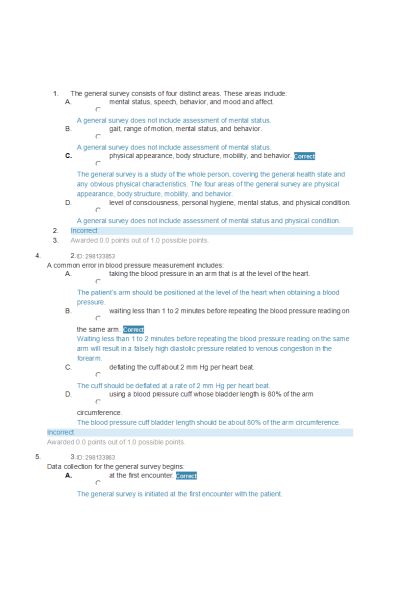- Question: The general survey consists of four distinct areas. These areas include:
- Question: A general survey does not include assessment of mental status and physical condition.
- Question: A common error in blood pressure measurement includes:
- Question: Data collection for the general survey begins:
- Question: The general survey is initiated at the first encounter with the patient.
- Question: The Doppler technique:
- Question: The tympanic membrane thermometer:
- Question: Endogenous obesity is:
- Question: To perform an accurate assessment of respirations, the examiner should:
- Question: Physical appearance includes statements that compare appearance with:
- Question: An adult patient’s pulse is 46 beats per minute. The term used to describe this rate is:
- Question: The nurse records that the patient’s pulse is 3+ or full and bounding. Which of the following could be the cause?
- Question: Pain signals are carried to the central nervous system by way of:
- Question: Which of the following is the most reliable indicator for chronic pain?
- Question: Which of the following is true regarding cultural/racial differences in the treatment of pain?
- Question: What occurs during transduction (the first phase of nociceptive pain)?
- Question: What type of pain is short and selflimiting and dissipates after the injury heals?
- Question: Neuropathic pain implies an abnormal:
- Question: What is the source of deep somatic pain?
- Question: Which of the following has been found to influence pain sensitivity in women?
- Question: Specialized nerve endings that are designed to detect painful sensations are:
- Question: An older adult patient with dementia has a pain rating of 5 on the Pain Assessment in Advanced Dementia (PAINAD) Scale. The nurse should:
- Question: When taking the health history, the patient complains of pruritus. What is a common cause of this symptom?
- Question: A flat macular hemorrhage is called a(n):
- Question: A student nurse has been assigned to teach fourth graders about hygiene. While preparing, the student nurse adds information about the sweat glands. Which of the following should be included while discussing this topic?
- Question: Functions of the skin include:
- Question: Risk factors that may lead to skin disease and breakdown include:
- Question: What term refers to a linear skin lesion that runs along a nerve route?
- Question: The components of a nail examination include:
- Question: To determine if a dark skinned patient is pale, the nurse should assess the color of the:
- Question: An example of a primary lesion is a(n):
- Question: A scooped out, shallow depression in the skin is called a/an:
- Question: Bleeding into the periosteum during birth is known as:
- Question: Craniosynostosis is a severe deformity caused by:
- Question: Narrow palpebral fissures, epicanthal folds, and midfacial hypoplasia are characteristic of:
- Question: Kyphosis of the spine is common with aging. To compensate, older adults will:
- Question: Which statement is accurate related to aggravating symptoms or triggers of headaches?
- Question: Most facial bones articulate at a suture. Which facial bone articulates at a joint?
- Question: A severe deficiency of thyroid hormone leading to nonpitting edema, coarse facial features, dry skin, and dry coarse hair is known as:
- Question: Which of the following statements describing a headache would warrant an immediate referral?
- Question: What disease is characterized by a flat, expressionless, or masklike face, a staring gaze, oily skin, and elevated eyebrows?
- Question: A patient is admitted to the emergency room after a motor vehicle accident. The trachea is deviated to the left side. This finding is characteristic of:
- Question: The extraocular muscles consist of four straight or muscles and two slanting or
Muscles.
- Question: A slight protrusion of the eyeballs may be noticed when examining individuals who come from which ethnic/cultural group?
- Question: The location in the brain where optic nerve fibers from the temporal fields of vision cross over is identified as the:
- Question: Which of the following groups of individuals need to be tested for the presence of color blindness (deficiency)?
- Question: Which of the following statements is true in regard to the results obtained from use of the Snellen chart?
- Question: The lens of the eye functions as a:
- Question: When inspecting the eyeballs of an African American individual, which of the following might the examiner expect to observe?
- Question: The normal color of the optic disc is:
- Question: Which of the following is an expected response on the cover test?
- Question: Which of the following findings is associated with Horner syndrome?
- Question: Decreased vision in the elderly may be due to which of the following conditions?
| Instituition / Term | |
| Term | Uploaded 2023 |
| Institution | NR 302 Health Assessment I |
| Contributor | Irina |














